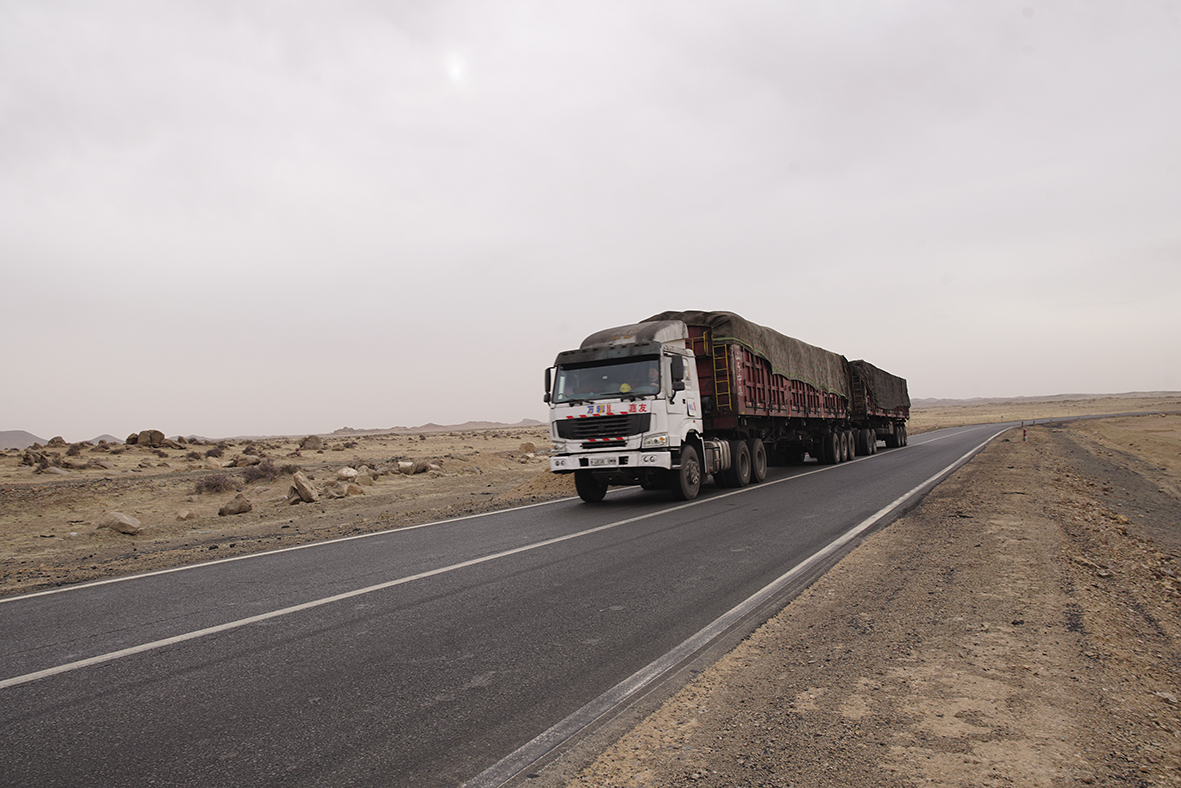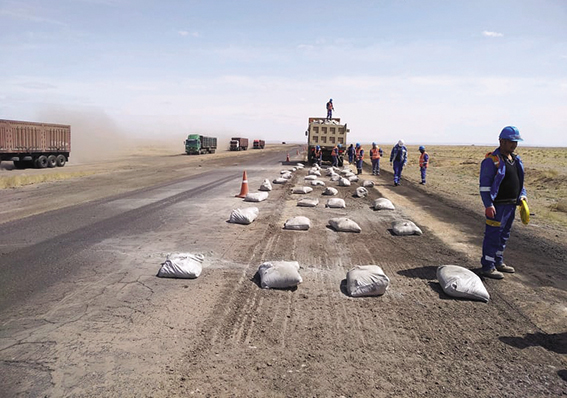L.Nyambayar: We strive to look at the bigger picture when solving problems

Mongolian Economy Magazine spoke with L. Nyambayar, Director of Infrastructure and Logistics Department at Erdenes Mongol LLC.
-What infrastructure projects are being implemented by Erdenes Mongol LLC?
-Erdenes Mongol LLC is in charge of infrastructure projects around the Asgat silver deposit, such as the construction of the natural gas pipeline. Our subsidiaries and related companies are carrying out several other projects as well. From 2014, Erdenes Mongol LLC took over the maintenance and repair of 239 km of road which run en route from deposits in Tavan Tolgoi to Gashuun Sukhait-Gants Mod border crossing.
-Could you tell us about the repair and use of the Gashuun Sukhait Road?
-Mongolia’s coking coal is exported through the Gashuun Sukhait border crossing. For instance, 20.6 million tonnes of coal was exported via the Gashuun Sukhait Road in 2019. The coal export volume which was 6.5 million in 2014 reached 20 million in this last year.
However, the revenue derived from road usage fell due to lower coal exports between 2015 and 2016. Consequently, during that period the repair work was ceased. The studies showed that around 10 percent of the road was in poor condition in 2017. Therefore, Erdenes Mongol LLC has been putting efforts into repairing the roads in the past few years. Owing to this, the road condition has significantly improved.
Public bodies, NGOs and drivers have been providing positive feedback with regard to the repair and maintenance of the Gashuun Sukhait Road. To illustrate, the Gashuun Sukhait Road was selected as one of the outstanding development projects implemented in Tavan Tolgoi by the Bayan Zam Transporters Association in 2019. So far, Erdenes Mongol LLC has invested more than 25 billion MNT in the repair and maintenance of the road.
Furthermore, they contribute around 8 to 9 billion MNT each year to Gashuun Sukhait Road LLC for road management, police services, health check-ups and other necessary activities. Within this framework, around 5 km of road was paved in 2017, another 5 km in 2018 and 48.5 km in 2019. To strengthen the quality of the Gashuun Sukhait Road, we built additional layers extending the road thickness to 11-12 cm.
Due to the COVID-19 outbreak and border restrictions, the exports fell this year. As a result, we had to postpone planned repair works. In 2020, we coated a 9.2 km road and began utilizing cutting edge technologies to restore the road condition. One example is the Gashuun Sukhait Road which is mainly used by heavy trucks. This becomes the reason for frequent road cracking all year around. In the last two years, we used a cold mix asphalt which can be applied in all seasons to restore potholes and wide cracks on the road.

-What Erdenes Mongol LLC is doing to improve the working conditions of coal transporters?
-Not only road repair and maintenance is of significant importance to us, the related infrastructure projects and health and safety of drivers matters as well. Every day, some of our drivers experience mechanical failures or even breakdowns. In that case, a driver must pull off the road so other trucks could pass safely. Even one truck can halt coal exports for that day. That is why we have increased the number of parking lots, garbage cans and restrooms along the road. Furthermore, last year, with Unitel, an information technology company, we installed four telecommunication antennas on the way from the mines to the border crossing. This enables drivers to make emergency calls during their duty on the road. For drivers who spend 24 hours in their truck cabin, radio boxes were installed with the support of NGOs operating in Mongolia.
In the past two years, we have added around 800 road signs to improve road safety. It might seem that we are merely concerned with the road but it is more than that. The road is part of the transport system that includes more than 10,000 drivers and there are many people who are providing various services to them. It indeed creates greater concentration than soums. The National Police Agency has been providing its services on a contractual basis for the last three years. Following the campaign called “We only live once” which was launched jointly with the National Police Agency, the rates of violation and crimes dropped considerably in the region.
Also, the drivers who work in dusty environments received health checkups in 2018. This year, the Ministry of Health is collaborating with us to conduct health checkups. Moreover, with the help of media companies, we published a magazine for drivers. Erdenes Mongol LLC worked together with the General Authority for Social Insurance to carry activities promoting the importance of social insurance.
I would like to emphasize the fact that we strive to look at the bigger picture when solving problems. Erdenes Mongol LLC should not leave the well being of drivers out of the picture by saying it is the sole responsibility of their employers or the Ministry of Health.
-The coal is the main source of revenue for Mongolia. How would you evaluate the Gashuun Sukhait Road’s impact on government revenue?
-In 2019, 56 percent of total coking coal was exported via Gashuun Sukhait Road. Owing to this, 10,000 drivers have jobs and can support their families. Moreover, along the road, auto repair shops and small businesses are being created. Over the past years, domestic companies began taking over auto repair services. Currently, we are building a service center that has 2,500 parking spaces, a food court, a laundry room, rehabilitation, break rooms, auto repair shops and which will offer other necessary services.
-Has soil erosion reduced since the road has been built?
Previously, there were trucks that illegally transported coals eroding the soil. To solve this issue, we strengthened control over illegal transportation. In regard to coal transportation for long distances, the trucks use the paved road from the mines to Tsagaan Khad but for the shorter distances, the trucks drive over earth roads. Hence, I would conclude that soil erosion has been reduced to a certain extent.
However, during the loading and unloading process, coal dust, a major air pollutant, is emitted. In order to reduce the coal dust emission, the unloading area needed to be paved. For example, in China, the coal is loaded and unloaded in a closed coal yard. Also, we need to put certain restrictions on the transportation of uncovered coal. Today, over 2,000 vehicles are transporting coal via Gashuun Sukhait Road.
-There is a growing fear that coal transportation via road may decline due to the railway en route from Tavan Tolgoi to Gashuun Sukhait. How do you see road transportation in the future?
In the past, we experienced an upward trend in exports of coal. Regardless of the demand, the supply largely depends on the capacity of our border crossings. On a given day, only between 1,500 to 1,600 trucks can pass through the Gashuun Sukhait border crossing. Thus, in 2019, the Government of Mongolia took an initiative to expand the capacity of the border crossings. We hope it will boost coal exports in the near future. There are a number of ongoing infrastructure projects, but the capacity of border crossings must be at the center of our focus. Only in this way, will we be able to maintain coal transportation via road.
Under the framework of enhancing exports from Tavan Tolgoi, the road constructions namely a 270 km road en route to Tsagaan Del Uul Port, 435 km road to Khangi Mandal Port and 250 km road to Gashuun Sukhait Port will be carried out jointly by the Government and private sector. This could lead to an increase in coal exports to Bayan-Nuur, Alxa League and Baotou which are the prefectures of the Inner Mongolia Autonomous Region. Due to these reasons, I would say that road transportation is likely to be accelerated.